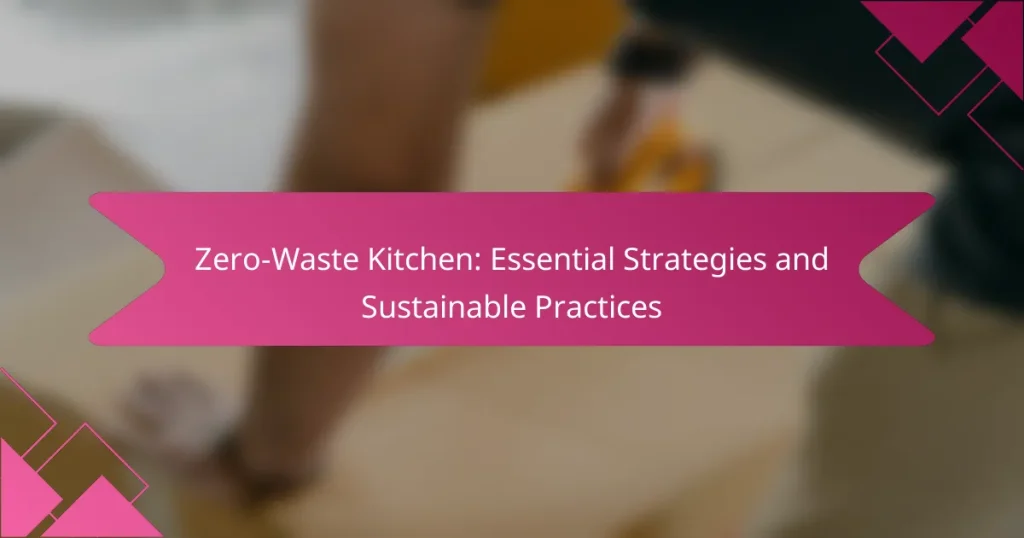Creating a zero-waste kitchen is an essential step towards a more sustainable lifestyle, focusing on minimizing food waste and maximizing resource efficiency. By implementing strategies such as meal planning, bulk buying, and composting, you can significantly reduce waste while making the most of your ingredients. Embracing reusable tools and smart shopping habits not only helps the environment but also enhances your cooking experience.
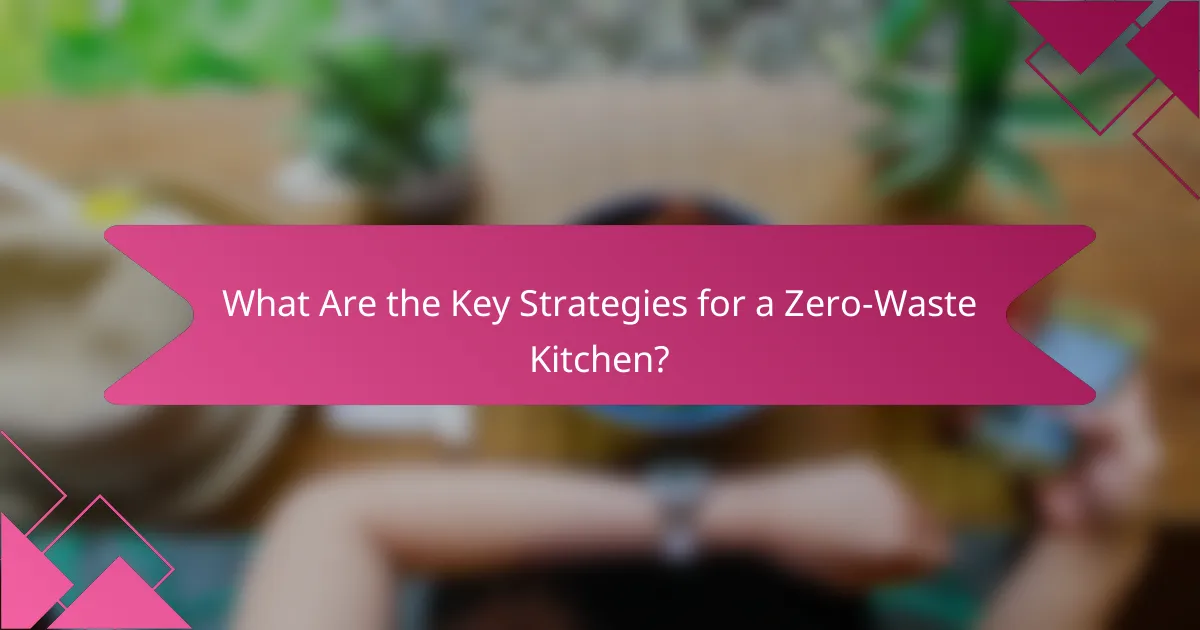
What Are the Key Strategies for a Zero-Waste Kitchen?
Key strategies for a zero-waste kitchen focus on minimizing food waste and maximizing resource efficiency. Implementing practices like meal planning, bulk buying, composting, using reusable containers, and food preservation techniques can significantly reduce waste and promote sustainability.
Meal planning
Meal planning involves organizing your meals for the week to avoid buying unnecessary ingredients and wasting food. Start by creating a menu based on what you already have, and then make a shopping list to ensure you only purchase what you need. This practice can help reduce impulse buys and leftover ingredients that often go unused.
Consider using apps or templates to streamline your meal planning process. Aim to incorporate versatile ingredients that can be used in multiple recipes, which can further minimize waste.
Bulk buying
Buying in bulk can significantly reduce packaging waste and lower costs over time. Look for local stores that offer bulk bins for grains, nuts, and spices, allowing you to purchase only the amount you need. Bring your own containers to avoid single-use plastic bags.
When bulk buying, check for expiration dates and choose items that have a longer shelf life to ensure you can use them before they spoil. This strategy is particularly effective for non-perishable items.
Composting
Composting is the process of recycling organic waste, such as fruit and vegetable scraps, into nutrient-rich soil. Setting up a compost bin at home can divert food waste from landfills and reduce greenhouse gas emissions. You can start with a simple bin or use a compost tumbler for easier aeration.
Be mindful of what you compost; avoid meat, dairy, and oily foods, as they can attract pests. Instead, focus on plant-based scraps, coffee grounds, and eggshells to create a healthy compost mix.
Reusable containers
Using reusable containers is a fundamental practice for a zero-waste kitchen. Invest in glass, stainless steel, or silicone containers to store food, leftovers, and bulk items. These containers not only reduce waste but also help keep food fresh longer.
Label your containers with dates to track freshness and ensure you consume items before they spoil. This practice can help you manage your pantry better and minimize food waste.
Food preservation techniques
Food preservation techniques, such as freezing, canning, and dehydrating, extend the life of perishable items and reduce waste. Freezing fruits and vegetables at their peak freshness preserves their nutrients and flavor. Canning can be a rewarding way to store seasonal produce for later use.
Consider learning simple preservation methods like pickling or fermenting to add variety to your meals while minimizing waste. Always follow safe preservation guidelines to ensure food safety and quality.
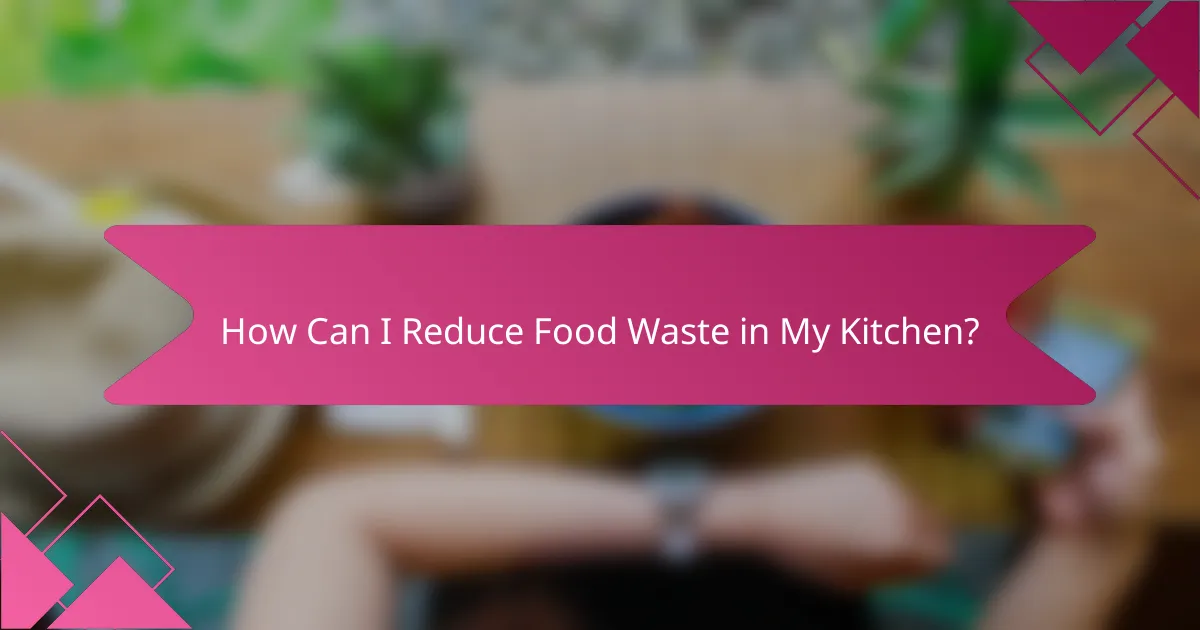
How Can I Reduce Food Waste in My Kitchen?
Reducing food waste in your kitchen involves implementing practical strategies that minimize excess and maximize the use of available ingredients. By adopting smart shopping habits, proper food storage techniques, and creatively using leftovers, you can significantly lower waste and contribute to a more sustainable kitchen environment.
Smart shopping habits
To reduce food waste, start by planning your meals for the week before shopping. Create a grocery list based on your meal plan and stick to it to avoid impulse purchases that may go unused. Consider buying in bulk for non-perishable items, but be cautious with perishable goods to prevent spoilage.
Choose seasonal and local produce whenever possible, as these items are often fresher and have a longer shelf life. Additionally, check for discounts on items nearing their expiration date, but only if you can use them promptly.
Proper food storage
Effective food storage is crucial in minimizing waste. Store fruits and vegetables in the right conditions; for instance, keep apples in the fridge to prolong freshness, while bananas do better at room temperature. Use airtight containers for leftovers to maintain quality and prevent spoilage.
Label your food with dates to keep track of freshness. A simple system can help you prioritize what to use first, reducing the chances of forgotten items going to waste. Regularly check your pantry and fridge to use older items before new purchases.
Using leftovers creatively
Transforming leftovers into new meals is an excellent way to reduce waste. Use leftover vegetables in soups, stir-fries, or omelets. Cooked grains can be repurposed into salads or grain bowls, while stale bread can be turned into croutons or breadcrumbs.
Consider batch cooking and freezing portions for later use, which can help you avoid waste while ensuring you always have meals ready. Get creative with recipes that allow for ingredient substitutions based on what you have left, making cooking both fun and resourceful.
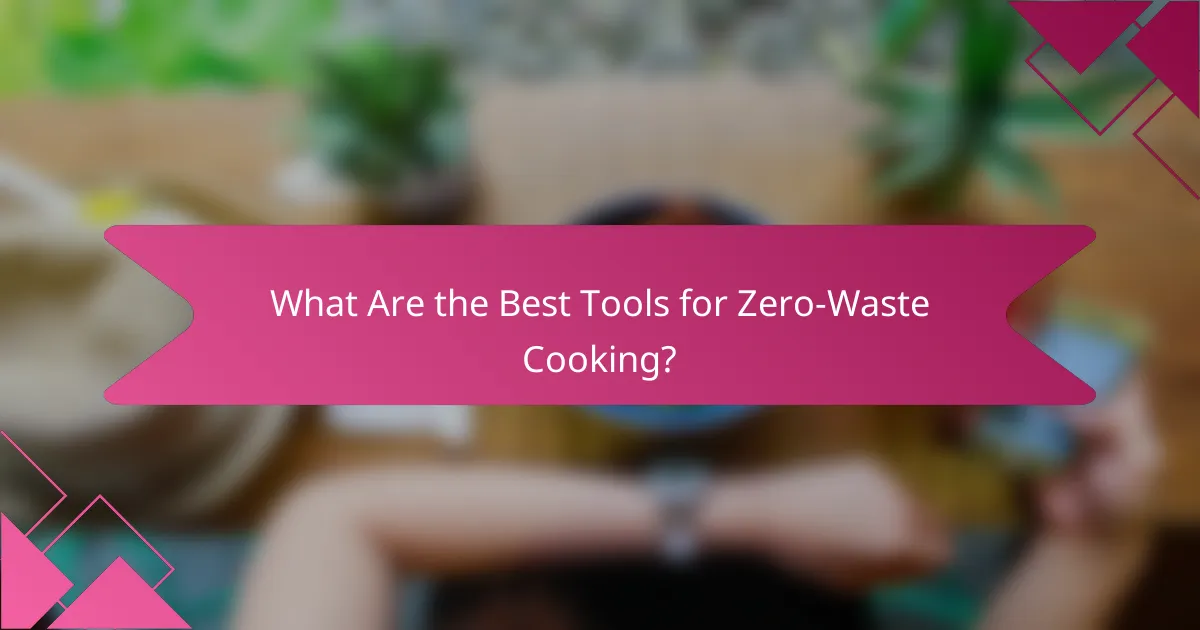
What Are the Best Tools for Zero-Waste Cooking?
The best tools for zero-waste cooking focus on reusability and sustainability, helping to minimize waste while preparing meals. Essential items include reusable produce bags, glass storage jars, and compost bins, each serving a specific purpose in reducing environmental impact.
Reusable produce bags
Reusable produce bags are an excellent alternative to single-use plastic bags when shopping for fruits and vegetables. Made from materials like cotton or mesh, these bags allow you to transport produce without generating waste. Look for bags that are machine washable for easy maintenance.
When selecting reusable produce bags, consider their size and durability. A variety of sizes can accommodate different types of produce, from small berries to larger items like cabbage. Aim to have at least five to ten bags on hand to cover your shopping needs.
Glass storage jars
Glass storage jars are ideal for storing leftovers, bulk items, and meal prep ingredients, promoting a zero-waste kitchen. Unlike plastic containers, glass is non-toxic and can be reused indefinitely, reducing the need for disposable packaging. Choose jars with airtight lids to keep food fresh longer.
Invest in a range of sizes, from small jars for spices to larger ones for grains or pasta. Consider labeling jars to easily identify contents, which can help reduce food waste by ensuring you use items before they expire.
Compost bins
Compost bins are essential for managing food scraps and organic waste, transforming it into nutrient-rich compost for gardening. By composting, you divert waste from landfills and contribute to a sustainable cycle of food production. Choose a bin that suits your space, whether it’s a small countertop model or a larger outdoor composter.
When composting, remember to include a mix of green materials (like fruit peels) and brown materials (such as dried leaves) for optimal decomposition. Regularly turning the compost helps aerate it and speeds up the process. Aim to compost at least 30% of your kitchen waste to make a significant impact.
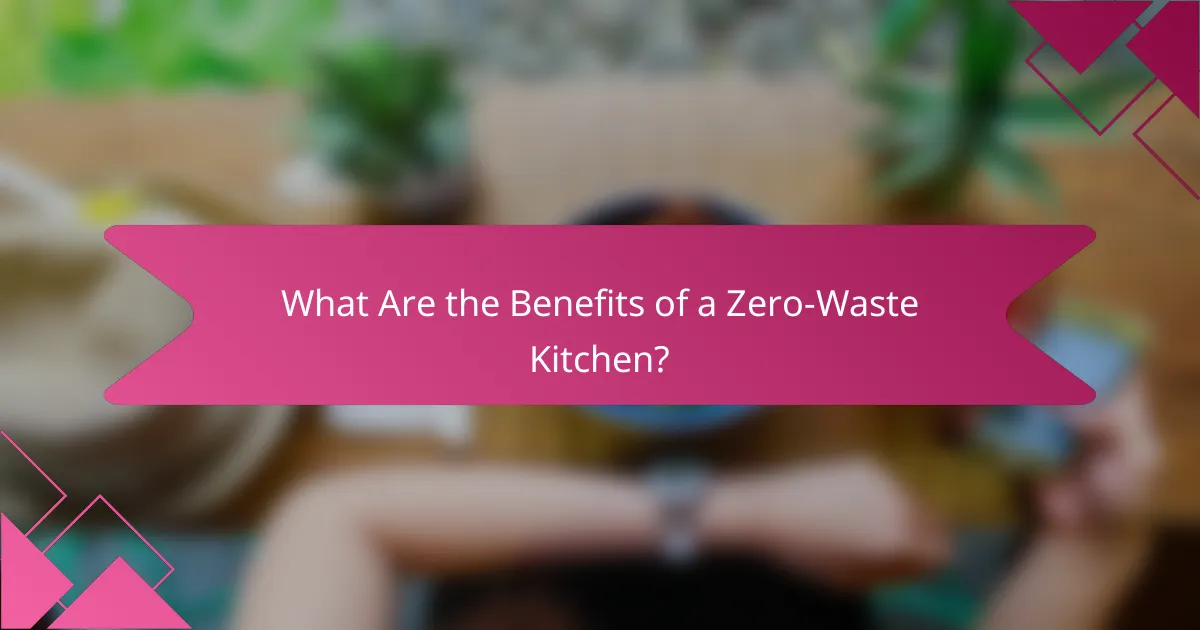
What Are the Benefits of a Zero-Waste Kitchen?
A zero-waste kitchen minimizes waste and maximizes resource efficiency, leading to various benefits. These advantages include a positive environmental impact, cost savings, and improved health outcomes.
Environmental impact
A zero-waste kitchen significantly reduces the amount of food waste that ends up in landfills, which contributes to greenhouse gas emissions. By composting organic materials and utilizing reusable containers, you help conserve resources and reduce pollution.
Implementing practices like buying in bulk and choosing products with minimal packaging can further decrease your carbon footprint. This approach not only protects the environment but also promotes sustainable living in your community.
Cost savings
Transitioning to a zero-waste kitchen can lead to substantial cost savings over time. By reducing food waste, you can save money on groceries, as you will be using what you purchase more effectively.
Buying in bulk often comes at a lower price per unit, and using reusable items instead of disposable products can cut down on ongoing expenses. Consider tracking your spending to identify areas where you can save by adopting zero-waste practices.
Health benefits
A zero-waste kitchen encourages healthier eating habits by promoting the use of fresh, whole foods rather than processed items. This shift can lead to better nutrition and overall well-being.
Additionally, reducing reliance on packaged foods minimizes exposure to preservatives and artificial ingredients. By focusing on cooking from scratch and utilizing seasonal produce, you can enhance both your diet and your cooking skills.

How Do I Start a Zero-Waste Kitchen?
To start a zero-waste kitchen, begin by evaluating your current waste practices and identifying areas for improvement. Implementing sustainable practices will help reduce food waste, packaging, and other disposables in your kitchen.
Assess current waste habits
Understanding your current waste habits is crucial for transitioning to a zero-waste kitchen. Track the types and amounts of waste you generate over a week, focusing on food scraps, packaging, and disposables. This assessment will highlight the biggest contributors to your waste.
Consider using a waste diary or app to log your findings. This data will help you pinpoint specific areas where you can make changes, such as reducing plastic packaging or composting food scraps.
Set achievable goals
Setting realistic and achievable goals is essential for maintaining motivation in your zero-waste journey. Start with small, specific targets, such as reducing food waste by a certain percentage or eliminating single-use plastics over a few months.
For example, aim to switch to reusable bags and containers within the first month, then gradually incorporate composting and bulk shopping. Regularly review your progress and adjust your goals as needed to keep moving forward.
Educate family members
Involving family members in your zero-waste kitchen efforts is vital for success. Educate them about the benefits of reducing waste and how their actions contribute to a more sustainable lifestyle. Share information through discussions, workshops, or even fun activities like cooking together with leftovers.
Encourage everyone to participate by assigning specific tasks, such as meal planning or managing recycling. Creating a shared commitment will foster a supportive environment and make the transition smoother for everyone involved.
